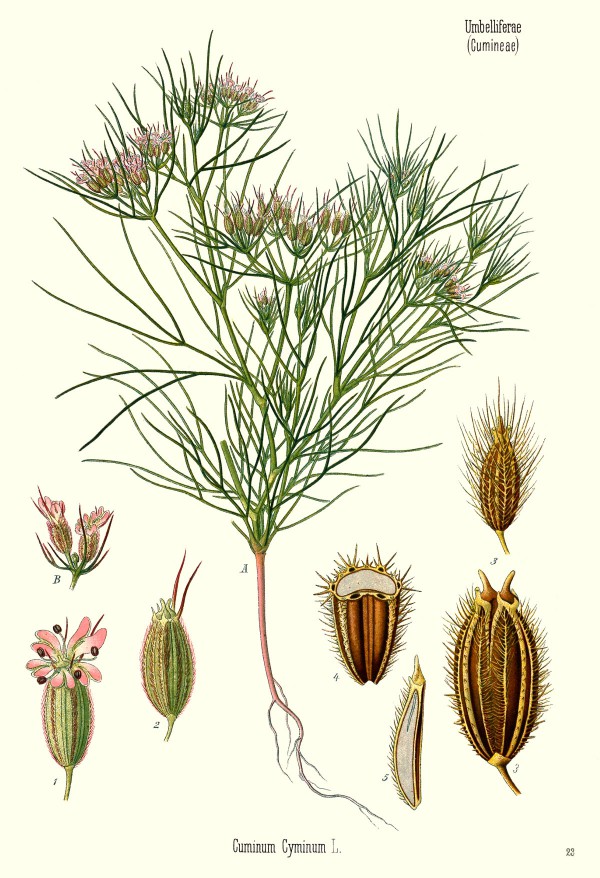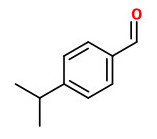Dies ist eine alte Version des Dokuments!
Cuminum cyminum L. - syn. Cuminum odorum Salisb. - Apiaceae - cumin, Kreuzkümmel
Annual herb, up to 50cm tall, native from the Mediterranean to India, widely cultivated.
„Cumin can be used ground or as whole seeds. It helps to add an earthy and warming feeling to food, making it a staple in certain stews and soups, as well as spiced gravies such as chili… In Sanskrit, Cumin is known as Jira. Jira means that which helps digestion. In Ayurvedic system of medicine, dried Cumin seeds are used for medicinal purposes.“ http://en.wikipedia.org/wiki/Cumin
The main components of Cuminum cyminum seed oil (completely different from Carum carvi seed oil!) were p-mentha-1,4-dien-7-al (27.4%), cuminaldehyde (16.1%), α-terpinene (12.8%), and α-pinene (11.4%).
[Antibacterial Activity of Cuminum cyminum L. and Carum carvi L. Essential Oils. Nicola S. Iacobellis , Pietro Lo Cantore , Francesco Capasso and Felice Senatore, J. Agric. Food Chem., 2005, 53 (1), pp 57-61]
„The inhibitory activity of Cuminum cyminum seed-isolated component was evaluated against lens aldose reductase and alpha-glucosidase isolated from Sprague-Dawley male rats and compared to that of 11 commercially available components derived from C. cyminum seed oil, as well as quercitrin as an aldose reductase inhibitor and acarbose as an alpha-glucosidase inhibitor. The biologically active constituent of C. cyminum seed oil was characterized as cuminaldehyde by various spectral analyses. The IC(50) value of cuminaldehyde is 0.00085 mg/mL against aldose reductase and 0.5 mg/mL against alpha-glucosidase, respectively. Cuminaldehyde was about 1.8 and 1.6 times less in inhibitory activity than acarbose and quercitin, respectively. Nonetheless, cuminaldehyde may be useful as a lead compound and a new agent for antidiabetic therapeutics.“
[Cuminaldehyde: aldose reductase and α-glucosidase inhibitor derived from Cuminum cyminum L. seeds., Lee, H. S., Journal of agricultural and food chemistry, Vol.53(7), 2005, 2446-2450]
„GC-MS analyses of cumin essential oils identified 26 constituents, representing the 80.0% of the total oil. The main components of cumin essential oil were γ-pinene (27.4%), p-cymene (20.49%), cuminal (20.39%) and β-pinene (12.75%). In a study carried out by Iacobellis et al. p-mentha-1,4-dien-7-al, cuminal, γ-pinene and β-pinene were seen to be the major constituents of cumin oil. These findings agree with those results presented here, except for p-mentha-1,4-dien-7-al, which was not found, and p-cymene, which represented 20.49% of the total.“
[Chemical Composition of the Essential Oils Obtained From Some Spices Widely Used in Mediterranean Region. Manuel Viuda-Martos, Yolanda Ruíz-Navajas, Juana Fernández-López, José Angel Pérez-Álvarez, Acta Chim. Slov. 921 2007, 54, 921-926]
„Essential oil yields were 0.03% in roots, 0.1% in stem and leaves, and 1.7% in flowers. Major components of the oils were bornyl acetate (23%), α-terpinene (34%), and γ-terpinene (51%) in roots, stems and leaves, and flowers, respectively. In all C. cyminum organs, total phenolics content ranged from 11.8 to 19.2 mg of gallic acid equivalents per gram of dry weight (mg of GAE/g of DW). Among the polyphenols studied, 13 were identified in roots, 17 in stem and leaves, and 15 in flowers. The major phenolic compound in the roots was quercetin (26%), whereas in the stems and leaves, p-coumaric, rosmarinic, trans-2-dihydrocinnamic acids and resorcinol were predominant. In the flowers, vanillic acid was the main compound (51%).“
[Essential Oils, Phenolics, and Antioxidant Activities of Different Parts of Cumin (Cuminum cyminum L.). Iness Bettaieb, Soumaya Bourgou , Wissem Aidi Wannes , Ibtissem Hamrouni , Ferid Limam , and Brahim Marzouk, J. Agric. Food Chem., 2010, 58 (19), pp 10410-10418]
Main components of cumin seed supercritical CO2 extract (SFE) were cuminaldehyde (30.5%) and the corresponding alcohol, 4-(1-methylethyl)-p-cymen-7-ol (cuminyl alcohol, 23.5%).
[Optimization of supercritical CO2 extraction and characterization of antifungal activity of essential oils in Cuminum cyminum L., Hu, L.F., He, J., Feng, J.T., Zhang, X., Australian Journal of Crop Science, 7(12), 2013, 1809] http://www.cropj.com/feng_7_12_2013_1809_1813.pdf

Köhler,F.E., Medizinal Pflanzen, vol.3 t.23 (1890)
http://plantgenera.org/species.php?id_species=297909


